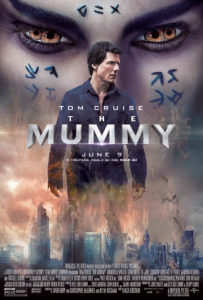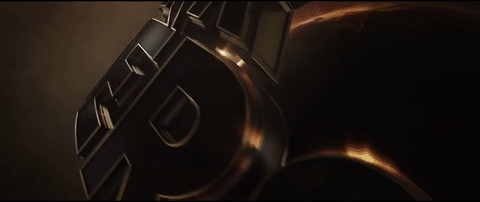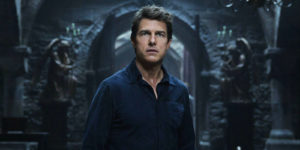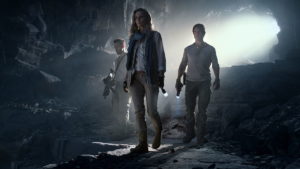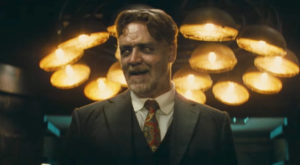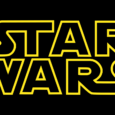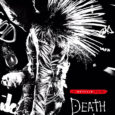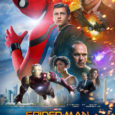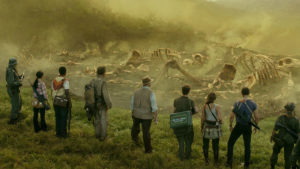When Iron Man debuted in theaters in 2008, audiences had no idea that it would completely change the landscape of film-making forever. It marked the birth of the Marvel Cinematic Universe. The MCU became a collection of movies featuring different characters all tied together as a way to multiply audience interest and profits for otherwise uninteresting movies. While Marvel pioneered the scheme, other studios quickly jumped on board, notably Marvel’s main competitor, DC Comics. Universal Pictures recently decided to dust off their “Monsters” properties and build their own Cinematic Universe. The Mummy marks the first film in what they’ve christened “Dark Universe.” But the question remains; is The Mummy worthwhile?
From the very start, Universal wanted to make sure audiences were aware that The Mummy is part of a larger framework. With press releases and announcements of Johnny Depp playing the Invisible Man, this felt unnecessary. The studio has even inserted a logo variation that morphs the famous “Universal Pictures” vanity logo into the words “Dark Universe,” almost like a new entity that produced the movie. It’s an odd addition, one done out of hubris more than anything else, and it’s completely ridiculous. It would be as if Iron Man began with a logo touting it as “A Marvel Cinematic Film.”
The film itself opens in an equally bizarre way: on the burial of a Templar Knight in twelfth century England. It then quickly transitions to modern-day London before flashing back to Egypt and summarizing the history of Ahmanet and her quest for power, all told through a narration by Russell Crowe’s character. Why any of this was necessary I can’t say. The only thing I can think of is that the film’s writers, of which there are six, had no faith that audiences would have been able to understand the hook without having it spelled out. That theory also explains the immense amount of verbal exposition we get along the way. For a film that’s as steeped in lore as The Mummy, I would expect an excess of expository dialogue, but Universal really took advantage of my expectations.
Most of the film gets bogged down from how hard it is to like Tom Cruise’s character. Nick…Something Or Other is an Army Sergeant/thief who has his sights set on “liberating” whatever valuables he happens to find in modern-day Iraq. He makes no excuses for his deception and his main motivation throughout the film is saving himself. There’s a slight glimmer of goodness in his character, which is dashed as quickly as it appears by way of a sad attempt at levity. I doubt the writers even realized that their throw-away joke negated any positive quality in the character, because if they did, they should have worked harder to make him more likeable.
The dislike of Cruise’s character is compounded by how terribly the writers treat his female counterpart. Nick takes advantage of archeologist Jenny Halsey (Annabelle Wallis) by lying to her, sleeping with her, and stealing her map to the location of what he believe is “treasure,” but not once does he show remorse for his actions. However, when he later discovers her secret that she’s been working with a covert team of “archeologists,” she’s made to feel terrible for her actions and apologizes profusely. Even watching this through the eyes of a dude, I could see the incongruity plain as day.
As expected, the movie makes a number of humorous attempts through its big, loud action sequence but most of them are so trite and obvious that they fall flat. Not to mention that some of the biggest jokes happen at the most inopportune moment, which made it uncomfortable to even enjoy them.
The humor was another pratfall the movie continued to make. Many of the jokes happen with unfortunate timing, such as when danger was at its highest. This created a strange juxtaposition that felt awkward. Am I supposed to laugh as Tom Cruise is about to get a dagger plunged into his heart? According to the writers, yes, I am.
I can’t say that the film is entirely bad, though. It does a few things right, most notably the casting of Sofia Boutella as the titular Mummy. Boutella has an amazing onscreen presence. The way she plays Ahmanet is threatening, unrelenting, and imposing, but she also manages to ply sympathy when needed. The only downside is how much her talent is wasted on a one-note villain. Granted, Ahmanet has more depth than both Cruise’s and Wallis’s characters, but her antagonism just comes off as boring. She’s the ultimate unstoppable evil that can be easily stopped by a MacGuffin.
Then you have Russell Crowe, whose appearance in this film is solely to expand the Dark Universe. Crowe plays Dr. Henry Jekyll. Yep, that Dr. Jekyll. He was a joy to watch as he seemed to be the only person in the ensemble who bothered getting into character. While I did like the way the film introduced the Jekyll/Hyde connection, I feel like they overdid it. In a case like this, as most of Marvel’s films have shown, a little goes a long way. Universal, on the other hand, didn’t seem to trust their audience would get the allusion and needed to center an entire action scene on just how badass Mr. Hyde could be. While it was a fun scene, it slowed down the pacing of the film and took some of the spotlight away from the Mummy, who should have always been the focus of the film.
For a movie that’s meant to kickstart a cinematic universe full of classic monsters, The Mummy lacks any sort of horror or thrills. It’s overflowing with cheap jump scares and cringe inducing creepiness (like Cruise being covered in rats), and those grow old fast. It also lacks the charm that 1999’s The Mummy starring Brendan Fraser had. At this point, it must be asked: what is this Mummy flick supposed to bring to the table, besides over-the-top action pieces?
Would I say The Mummy was a good movie? Nope. I will say that as the tent pole of the “Dark Universe,” it was fun, and at the very least, it opened the doors for films featuring a more diverse cast of classic monsters. After years of countless Dracula, Frankenstein and Werewolf movies, we finally have the chance to gets movies centered on the Hunchback of Notre Dame, Dr. Jekyll and Mr. Hyde, and the Invisible Man. In the hands of the right writer and director, these movies have the opportunity to be mind-blowing. While The Mummy is mediocre at best, it deserves some credit.
Grade: C
If a tree falls in a forest, and a mythological gigantic ape picks it up to use it as a weapon, does it make a sound? Yes, that sound is me in the theater audibly uttering “wow” through a giddy smile. This is the true test Kong: Skull Island has to pass or fail. Could it not only entertain but “wow” audiences with its spectacle? Fortunately, it unquestionably amazes with its stunningly-crafted CG and scale, but it’s at the expense of smooth dialogue and strong characters.
In the latest Kong retelling, the story is as thin as you’d expect, since the emphasis is on the origins of these monsters. As the Vietnam war comes to an end, a group of determined scientists implores the government to send a military escort with them to an undiscovered island. Along the way, said scientists hire a tracker (Tom Hiddleston). Separately, a photographer tags along (Brie Larson). The plot broken down in a sentence is essentially “some dummies go to Kong’s island to study things.” I’m never a fan of being reductive, but a film isn’t supposed to make it so easy to do. Regardless, I suppose that’s not why we eagerly watch these types of popcorn blockbusters.
Commendably, Warner Bros. Pictures employs one of the strongest ensemble casts you’ll see in a movie all year. Hiddleston, recent Oscar winner Larson, Samuel L. Jackson, John Goodman, John C. Reilly, Toby Kebbell, Shea Whigham, Thomas Mann, and Jing Tian star, to name a few. The film also features a Straight Outta Compton reunion with cast members Jason Mitchell (Easy E) and Corey Hawkins (Dr. Dre). The casting aspect alone held so much promise on paper, but this potential felt largely squandered.
Sam Jackson and John C. Reilly are clearly taking liberties and enjoying it in their respective roles, but everyone else is strikingly forgettable. There’s attempted interplay between a couple of the marines that ultimately falls flat. Heavy-hitting actors Hiddleston and Larson are simply present to be a conduit of plot details for us, the audience. Most of what they do while on camera is react with the best surprised expression they can muster. Sure, the two have distinct occupations but it’s merely an excuse to carry them into this dangerous adventure. Not to mention, Hiddleston’s James Conrad did very little tracking at all. As far as definitive personality traits, I didn’t notice any from Hiddleston, Larson, or the many other expendable individuals.
As I touched on, Reilly and Jackson are a blast to watch as they chew up their scenery. Whether improvised or purposefully written, the jokes never seem to land pre-Reilly. Like he does in his prior comedic work, he has a natural delivery and general presence that inspires laughter. Jackson as Colonel Packard recited some insane lines in the vein of a cheesy ’90s action villain with such hilarious conviction. The duo was nothing short of a joy to see perform.
We have to praise the real star of the show: Kong. Everything about him in Skull Island exceeded my expectations. If your primary complaint of 2014’s Godzilla was “where’d that enlarged lizard thing go?,” prepare to be satisfied. Kong appears in the first 3 minutes, and they don’t hold back as a means to build tension (which I personally appreciated in the latest Godzilla effort). At times, he’s spotted merely walking around the island, and every frame he occupies feels majestic. Terry Notary put forth a tremendous motion-capture effort that added a surprising amount of nuanced personality to the familiar beast. More than that, Kong is written with a layer of ingenuity. In his several oversized-creature battles, he uses his surroundings and tools he might spot at random to their full potential to aid him in bringing down his enemies. Kong himself should satisfy the majority of moviegoers.
Another facet I appreciated from the picture was director Jordan Vogt-Roberts‘ work behind the camera. There are plenty of carefully constructed frames with a remarkable colorful concoctions. After the movie rushes past certain crudely-written scenes with one-dimensional supporting characters, Vogt-Roberts squeezes in intricately vibrant set pieces. Whether it’s a fast-paced action sequence involving an abundance of fire or Kong purely looking at a sunrise, he shows off his knack for capturing the beautiful production design in a visually-palpable way. Unfortunately, he’s not given many opportunities to display these skills on more than a couple occasions.
I may have levied quite a few criticisms against this flick. Nevertheless, a visit to the theater to see Kong: Skull Island on the silver screen is a good investment. If you expected occasional astounding visuals and fantastic monster fights, then Skull Island will distribute that in spades. Anticipating tangible character development and dialogue that doesn’t make you cringe is simply too much to ask. While we always prefer a satisfying mixture of both, Kong is still an enjoyable (literal) giant blockbuster. Also, don’t forget to remain seated for a post-credits tease. You’ll start to see how the larger Warner Bros. MonsterVerse starts to connect, and it’s very exciting.
Grade: C


